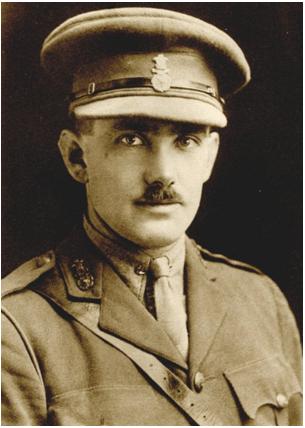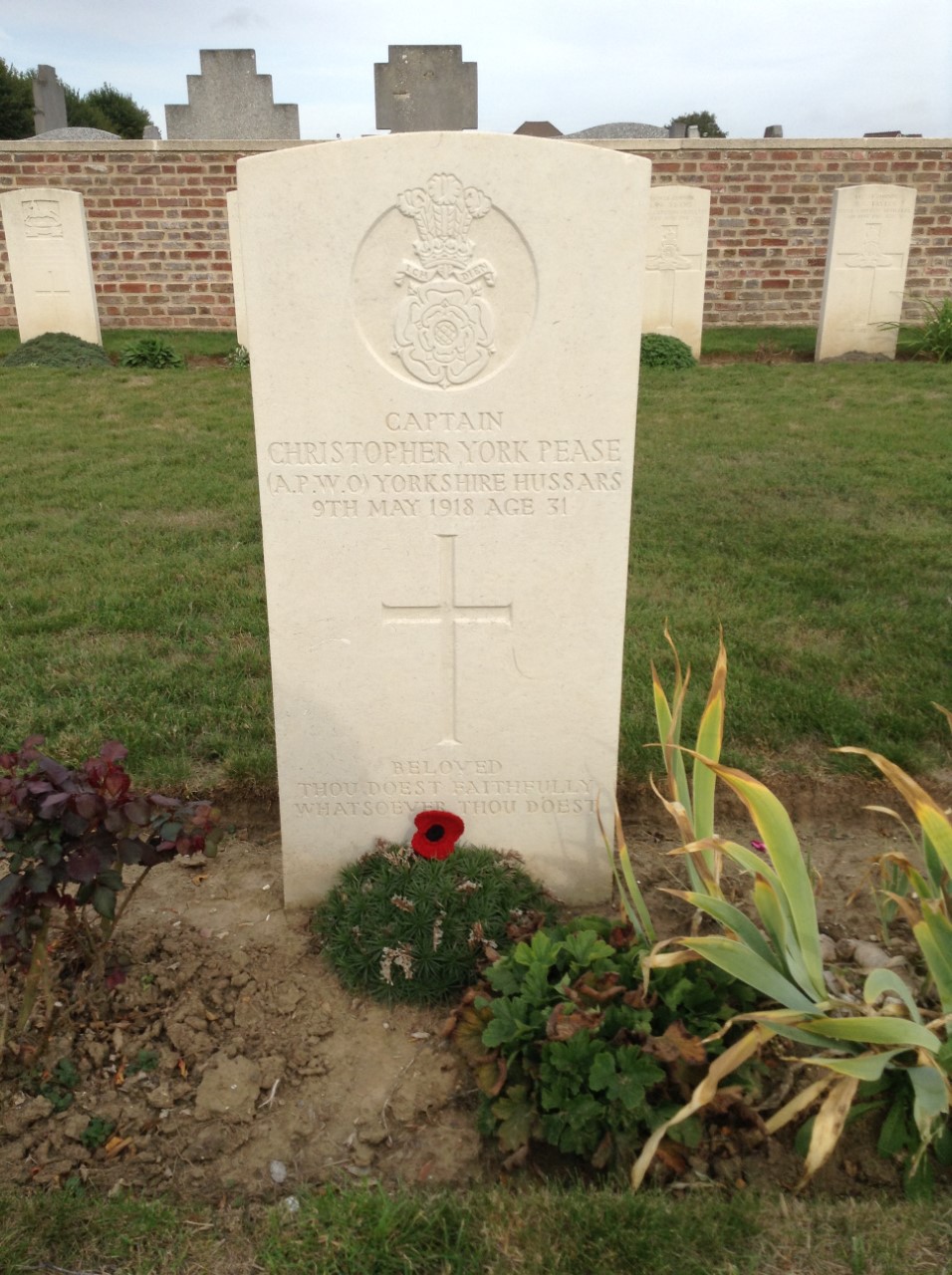
Note: The numbers in the square brackets refer to the references which are listed on the Captain Christopher Pease References Page.
Christopher York Pease was born on 24th June 1886 at 24 Kensington Palace Gardens, London[3]. He was the second son of Sir Alfred Edward Pease, 2nd Baronet, JP, DL, FRGS, of Pinchinthorpe, Guisborough, Yorkshire.
Sir Alfred was at one point MP for York and Cleveland, and also Resident Magistrate and Head of Native Affairs in the eastern Transvaal. His mother, who died in 1910, was Dame Helen Ann Pease, the daughter of Sir Richard Nicholas Fowler, 1st Baronet, MP, of Gastard, Wiltshire. His elder brother, Edward Pease (Coll.1894-1899), was severely wounded in Flanders in 1915 but survived to inherit his father’s title in 1939.
Christopher Pease spent much of his childhood in Algeria and on the Continent, and this gave him a lifelong love of travel. He came to Winchester from Horris Hill, Newbury, and in his last year stood on dress for OTH XV. He was a good shot with a rifle, and The Wykehamist (574, June 1918) assessed his athletic abilities in the following terms:
“Fond of games, he made his best mark at football and as a long-distance runner, and after leaving school was a good follower on foot with the local packs of harriers and beagles... He was a fine rider to hounds from earliest boyhood; as a mere child he won his spurs as the best rider in a large class at the Yorkshire Show at York, and was never happier than when at the top of the hunt with Cleveland or Hurworth Hounds.”
A few months after leaving school, having spent some time with his parents in the eastern Transvaal, he entered the offices of the family colliery business, Pease and Partners (Limited), Darlington, and was appointed a director soon afterwards
On December 22nd 1910, at Ingleby Arncliffe Church, Christopher Pease married Miss Philippa Margaret Johnson, the youngest daughter of Major Walter Johnson and Margaret Florence Bell[4], of Arncliffe Hall, Yorkshire.
Christopher and his wife lived at The Hollins, East Rounton which is 3 miles from Ingleby Arncliffe. He painted the mural on the wall at The Hollins[5].
Their daughter, Rachel Hebe Philippa Pease, was born on 19th December 1911 in Pinchinthorpe[4] and died on 5 Sep 1999 in Tasmania aged 87[4]. Their son, Ingram Edward Pease, was born on 28th February 1914 in Croft Hall, Darlington[4], and later went to Winchester as a War Exhibitioner (F1927-1932), but was killed in a flying accident near Loch Leven whilst serving as a member of the Auxiliary Air Force in February 1939.
After the outbreak of the First World War, Christopher Pease obtained a commission on 23rd September 1914 in 1/1st Yorkshire Hussars Yeomanry (Alexandra, Princess of Wales’s Own). His unit formed part of the Yorkshire Mounted Brigade, based on York in August 1914, but in early 1915 it was split up: RHQ and ‘A’ Squadron were attached to 50th (Northumbrian) Division, ‘B’ Squadron to 46th (North Midland) Division, and ‘C’ Squadron to 49th (West Riding) Division.
In May 1916 the regiment came together once more as Corps Cavalry for XVII Corps. However, according to de Ruvigny’s Roll of Honour, Christopher Pease, who was promoted Lieutenant on
1st June 1916, did not see active service overseas until 16th September 1916.
In August 1917 the regiment gave up its horses and was converted to an infantry role. In November, all 400 men – including Lieutenant Pease – were sent to 9th Battalion, West Yorkshire Regiment, which was re-designated 9th (Yorkshire Hussars Yeomanry) Battalion.
Christopher Pease was promoted to Captain on 25th February 1918.
By May 1918, his battalion was in the line near Vermelles in the Loos sector. The battalion war diary records the usual round of activity in the trenches in a relatively quiet area:
“May 1st 1918
Sickness (PVO) very prevalent in the Battalion. Eighty cases admitted to hospital in past few days.
May 2nd 1918
Battalion relieved by 6th Battalion York & Lancaster Regiment, and marched out into reserve. Battalion HQ & ‘C’ & ‘D’ companies in Vermelles; ‘A’ Company Le Rutovie Farm; ‘B’ Company Crossways Trench. Two Corporals and one other rank of 2nd Battalion, Royal Scots, 3rd Division, came in on left company (‘A’ Company) front at 2.30 p.m., having escaped from the German lines. Weather fine and warm.
May 3rd-5th 1918
Weather conditions fine and warm, inclined to thunder. Situation quiet.
May 6th 1918
Battalion relieved the 6th Battalion Yorkshire Regiment in north sector of St. Elie Section[7]. Dispositions: ‘A’ Company (Captain Foster) north grid 0B4 [?], one platoon holding Gordons Post; ‘B’ Company (Major Townsend) right front (Hair Pin Crater); ‘C’ Company (Captain Carnell) left front
(Border Redoubt, Slag View, Rat Creek); ‘D’ Company (Captain Grimshaw) 0B1 trench. Relief successfully completed by 4 p.m. Weather fine, bright sun, rain at night.
May 7th 1918
Nothing of importance.
May 8th 1918
Nothing of importance.
May 9th 1918
6th Battalion Yorkshire Regiment carried out a raid through our front from Gordon Post. One party lost its way and raided one of our posts and killed Captain F.A.W. Carnell. Lieutenant C.Y. Pease was killed by a 5.9 shell.

May 10th 1918
Battalion relieved by 9th Battalion, Sherwood Foresters, and marched out to billets at Bracquemont.
May 11th 1918
Captain Carnell and Lieutenant Pease buried at cemetery Mazingarbe.
Photographs of the cemetery and Captain Pease's grave, taken on 20th September 2018, can be found on the Memorial Visits page on this website.
Christopher Pease, who was aged 31 when he died, is listed in the battalion war diary as a Lieutenant, but this was some months after his promotion to Captain – the Commonwealth War Graves Commission states his rank as Captain. He was probably serving in a Lieutenant’s capacity until a vacancy for a Captain became available; ironically, Captain Carnell’s did so the same day that Christopher Pease himself died. Christopher Pease rests in grave III.C.8 of Mazingarbe Communal Cemetery Extension[9][10][11][12].
One of his fellow officers wrote that:
“We were so fond of him; he was such a good, genuine officer...He never spoke without having something to say, and men and officers respected him hugely... I feel so much that another of the best of Yorkshiremen is gone.”
Colonel Eley, of the Yorkshire Hussars, added:
“I was very fond of your husband, and had a great opinion of him as a soldier; he was always so reliable and cool.”
The following is an account of Christopher Pease’s death, from the family records[5]:
“On 9th May 1918, Christopher was in the front line at Givenchy. At 6.00 p.m. the British raided the German lines and the Germans retaliated with a heavy bombardment. Four hours later, Christopher went to the advance posts to hearten the men and to warn them to be prepared for a gas attack by the British at midnight. With his orderly, Private Owbridge of the 9th West Yorkshire Regiment, placed under Christopher because he required a little discipline, and “who was a nice, bright-eyed spare good looking intelligent man”, they went along the trenches, and often in the open to the advance posts, and a little before midnight he had completed this round.
Owbridge gives an account of what happened next. The shelling of the British lines was particularly heavy during the two hours before midnight, but Christopher “was very cheerful & happy and talked ... pleasantly a great part of the time. He went about and chatted just as if there were no shells falling about us. Out often into the open and in front of the lines to look at the wire and see that it was standing.
Having finished our round, we were getting across the open when he made the last remark. His words were, “I do not know what we have done to them, but they seem very vexed tonight”. We had just got near the parapet of the trench when a shell burst about 5 yards from us, it blew us both into the trench – we meant to jump down into it – and at the same time I heard Lieut Pease say, “I am” and fell dead on top of me in the bottom of the trench... I think he meant to say, “I am hit” but it was instantaneous and he was dead before he could say it.”
Christopher’s father’s records state that Christopher died at Givenchy[6][7]. From the Battalion’s War Diary[2] and a study of trench maps for the area[8] it is now clear that he died 3 miles south of Givenchy.
Sir J Gurney Pease, Bart takes up the biography:
“Notification of Christopher's death was made by telephone on 13th May, 1918 to my Father at Pinchinthorpe House, Guisborough. In every likelihood, the phone message was confirmed by letter which has not survived - else it was given to his widow who died on 10th June, 1959. All that has survived of what my father recorded was that Christopher was killed at Givenchy on 9th May 1918[7]. It is possible that he was told St. Elie and that Givenchy was the nearest identifiable location opposite St. Elie, though I cannot speculate upon that.
.jpg)
Christopher's grave is at Mazingarbe which together with my wife, I visited some years ago, as also at a later date it was visited by my daughter and two grand children. That grave was originally temporarily marked with a wooden cross which when replaced by a stone memorial was sent to my Father. I collected it and sent it to Christopher's daughter (herself now deceased) then living in Tasmania.”[6]
After Christopher’s death, his widow Philippa returned to Pinchinthorpe House, Guisborough[12].
Captain Christopher York Pease is listed on Ingleby Cross Village War Memorial.
It is likely that Captain Pease was entitled to the Victory Medal, and very possibly the British War Medal, 1914-18 [14].